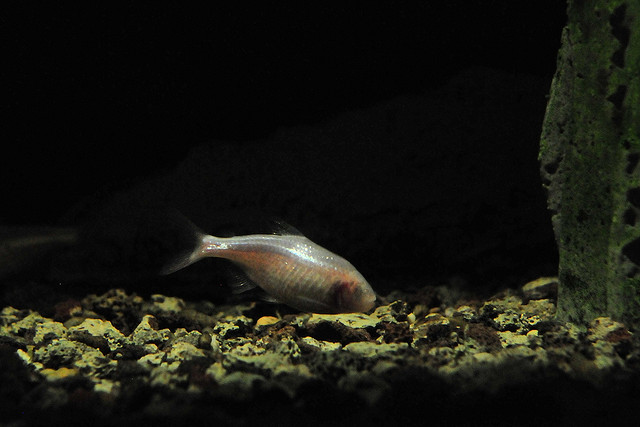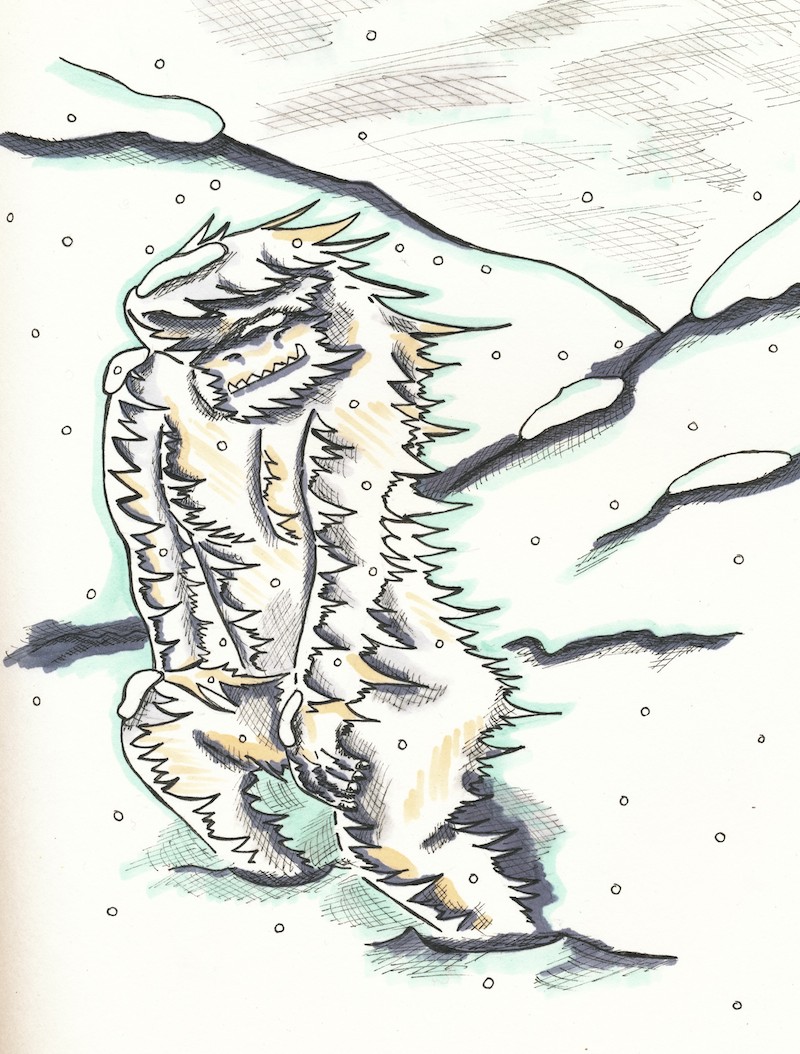I’ll scratch your back if you scratch mine
By Jennifer Seitz
It’s hard to be a wild animal. As if it wasn’t enough that their habitats are threatened and they are challenged by climate change, they are also besieged by humans equipped with cameras and spyglasses to watch their every little twitch.
“Enough with that!,” the Samango monkeys (Cercopithecus albogularis) in South Africa may have thought. ‘If you’re hanging out in our place, we might as well put you to good use and make you our bodyguards!’
Monkeys opting for a human security detail? Well, this is what a new scientific study published in the magazine Behavioral Ecology suggests. According to the study the monkeys use field researchers as human shields against predators. The researchers, headed by Katarzyna Nowak from Durham University have shown in an experiment that the monkeys felt much safer and stayed longer at their feeding sites when people were around.
The furry fellows are not only eating longer in the company of human onlookers, it has also made them change their snack locations. Like most of their colleagues Samango monkeys gobble up their food up in the trees where they are safe from ground-based predators. While observing trees, which had been prepared with feed buckets at different heights the researchers discovered that the monkeys enjoyed their meals closer to the ground than usual, because they seemed to feel even safer in the presence of the researchers.
Quite clever these little fur balls!
But Nowak and her team raised another serious point well beyond their clever monkeys. How accurate can behavioral studies with animals actually be when the mere presence of the researchers is enough to change their behavior
Who knows what’s going on in the forest when nobody is watching?!
Fears dead whale could burst
Uncertainty and worry are plaguing a small Canadian fishing village: Earlier this week, a blue whale carcass (80-feet long) washed up at the village’s shores. The dead body bloated as it filled up with methane due to decomposition. It’s now already doubled in size and it’s feared the carcass could explode any time. And no, it’s not funny at all as a Faroe Islands biologist could easily confirm. In November 2013, Faroese Television showed a clip of a dead sperm whale that had been lying on the beach for two days. When biologist Bjarni Mikkelsen made incisions in the whale’s side, the carcass exploded with a loud sound and released a pungent smell. But, the story doesn’t have to end this way – the gas could also simply seep out just like helium from a rubber balloon.
Ever hear of evolution ‘in reverse’?
How do you understand the term “evolution?” It’s synonymous with progress, development, advancement, right? But, sometimes evolution can also change direction.

Astyanax Mexicanus, a blind cavefish. Photo credit: CC BY-NC-SA 2.0 by Joachim S. Müller/flickr.com: http://bit.ly/1kcBaoO
Evolution is usually associated with developing new features to be able to adapt to environmental changes in certain regions. But, sometimes evolution can also go the other way. Called “regressive evolution,” the phenomenon describes nothing else but advancing in evolution by losing certain abilities or traits.
Cave-dwelling species, in particular, are affected by regressive evolution. These species have originally lived above ground and later, by geological events, were trapped below the earth’s surface. A very drastic example is Astyanax mexicanus, a blind and almost colourless, transparent fish species living in Mexican caves. It has a surface-dwelling counterpart that looks very much the same, just add a silverish color and, well, eyes. Both are the same species and are able to interbreed. In fact, the cavefish have eyes as embryos, but they never become fully developed. Instead of eyes, cavefish navigate with a tool that all fish have, a sensory system. But compared to thir overground counterparts, the blind fish system is about 50 times more effective.
It’s possible to find other examples in different habitats. Cimicidae (article in german), for example, have lost their ability to fly by regressing their wings during evolution. This also applies for lice (article in german). Snakes ran around on legs and feet a few million years ago, terrestrial vertebrates once had gills. And here’s another example we all know very well: humans. We lost our proud, ape-like tails during the process of evolution.
Do you see that as a loss? 🙂
The Yeti
Just as Sasquatch/Bigfoot, the Yeti is described as an ape-like species walking on two legs. He is said to be living in the Himalayan regions of Nepal and Tibet. And also, the Yeti’s roots can be traced to ancient narratives. But unlike what we understand the Yeti to be today, the natives of the Himalayas did not talk about an Abominable Snowman with white fur, but of an angry dark-haired gorilla- or bear-like creature that lived high in the mountains. (described in “Abominable Science” p.75).
A lot of movies have cemented the snowman-picture, for example the first ever Yeti movie “The Snow Creature” from 1954. The Yeti even has a guest appearance in the highly successful “Monsters, Inc (2001)” and is the namesake of the official airline of Nepal, Yeti Airlines. But when did the Yeti, this creepy creature that used to strike terror into the hearts of the Himalayan people, become cool? The story is much older than that of the Sasquatch or Nessie. According to H. Siiger the Yeti has always been a part of the region’s mythology, people have dozens of names for it. The name we use today is most likely a mispronunciation of the Sherpa name for the man from the mountains: Yeh-teh = animal of rocky places. When the first expeditions entered the rocky region, the expedition participants took the story back home.
In 1832 the first descriptions were published in travellers’ journals, talking about tall, bipedal creatures covered with long dark hair. Later footprints were reported. Similar reports have repeatedly been published until today. In 1925, N. A. Tombazi, a member of the Royal Geographical Society, reported a sighting at about 4,600 m. And during an expedition of the British Newspaper Daily Mail in 1954 mountaineering leader John Angelo Jackson (pdf) photographed footprints many of which many were unidentifiable (and therefore of Yeti origin?). The mystery of the snowman grew. And went fully ‘viral” (to use a modern term) when an expedition found what they believed to be a Yeti scalp.
Nessie – a dinosaur that arrived to late?
The Nessie mystery offers one of the best known pictures to prove the legend. Again, in the beginning there were stories told by elders. Not only about Loch Ness, a 37 kilometer long and 230 meter deep lake, the alleged abode of the creature. But the lake also happens to be in Scotland, a country with a rich folklore tradition. As “Abominable Science” (p.123) explains, even “water-based super-natural creatures had already lived for centuries” in Scotland. Just to name a few: The Stronsay Beast or the sea serpent of the Isle of Lewis, or the boobrie, the buarach-bhaoi (pdf) or the “Big Beast of Lochawe”, described as an “animal with 12 legs. Some say it was like a horse, others, like a large eel.”
But Loch Ness? Some think Nessie could be a plesiosaur, a species living in the Pleistocene epoch (2.5 million – 11,700 years ago). Scotland as a whole was covered by a solid ice sheet half a mile think, during the ice age some 18,000 years ago. That makes Nessie either very unlikely to be real, or a very late example of it’s kind. But the famous picture seems to be quite real, doesn’t it? The story of the Loch Ness monster and the associated picture started in the 1930s. “Abominable Science” (p.127) quotes a story of three anglers who were said to be the first eye witnesses of some strange creature in the Loch. Unfortunately they didn’t see anything in particular, but merely mentioned the presence of something strange. A newspaper published the story.
Three years later, another reporter, Alex Campbell, remembered the story when he came across another possible sighting of the Loch Ness monster. The sensationalist story he wrote brought the creature back to public debate. And it was King Kong (1934), the blockbuster movie that year, that finally ignited the run for Nessi. In the film, the giant ape has to take on a prehistoric Nessie-like creature providing the audience with an idea of the monster lurking in the lake. Loch Ness has since captured the imagination of generations and become a star attraction in the cryptozoology universe.











Feedback